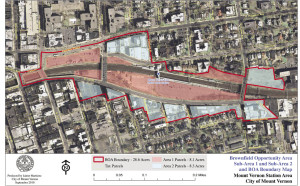Mount Vernon recently received a $354,607 state grant to revitalize 29-acres of dormant and potentially contaminated land around the Mount Vernon East train station three years after its initial application.
Mount Vernon is one of 26 communities to receive funding through the state Department of Environmental Conservation”™s Brownfield Opportunity Area grants totaling $10 million. Brownfields are underutilized industrial and commercial properties where the presence or potential presence of contamination has hindered redevelopment.
The Mount Vernon planning board is spearheading the initial phase of the project and identifying ways to capitalize on Mount Vernon”™s assets including the train stations and the existing commercial and industrial infrastructures. The project will target nine separate properties.

“This funding allows for municipalities to implement revitalization strategies to redevelop impacted areas,” said Louis J. Albano, acting planning commissioner and the project leader for the city of Mount Vernon. “We hope that these sites can become community assets again to increase jobs and expand the local tax base.”
The planning board will issue a request for proposals to hire a preliminary consultant by the end of the year, Albano said. Meanwhile, the planning board is conducting in-house meetings to map out practical uses for the southeast portion of Mount Vernon that borders the Bronx and Pelham and the underutilized parcels between the Mount Vernon East and Mount Vernon West train stations.
“What exists in the southeast portion are a combination of asphalt and concrete plants, auto repair shops, light manufacturing businesses and underutilized properties,” Albano said. “We”™ve got some businesses bordering the Mount Vernon train stations, but right down the middle of the train tracks is a big empty space.”
The plan is to develop the areas with corporate offices, residential homes and retail businesses to attract young professionals, new families and seniors who will have easy access to the city”™s downtown and its public transportation systems.
The Mount Vernon East train station was first identified as an opportunity area in 2009 through a comprehensive plan process that looked at expanding existing businesses and creating new transit-oriented developments, especially around Petrillo Plaza, the county”™s third-busiest bus hub next to the train station.
The city is considered “cost-burdened,” which means most residents spend more than 30 percent of their income on housing. Mount Vernon has the highest rate of unemployment in Westchester for adults, youth and minority youth, and the city”™s has been looking to improve this is by creating new jobs through this revitalization plan. But this isn”™t the city”™s first brownsfield redevelopment initiative.
Two years ago, Mount Vernon received a similar state grant of $435,160 to revitalize a 231-acre area with 20 potential brownfield sites located in the city”™s southeastern section called the Canal Village area. The grant totaled $6.5 million with the state spending more than $32 million on more than 100 ongoing revitalization initiatives at the time.
The redevelopment of brownfields has increased property value for businesses within a quarter to half a mile radius of the redeveloped site and increased job opportunities, Albano said.
“Redeveloping brownfield sites can create 90 to 100 jobs through the cleanup and construction phase and bring in new businesses,” Albano said. “Studies have shown that every dollar of public investment on brownfield leverages $8 in total investments through job creation, wages and taxes.”
Nearly a decade ago, the city had yet another brownfield revitalization project take place on the Sandford Boulevard corridor, where redevelopment attracted new businesses including national stores such as a Staples, Best Buy, Target, Bed Bath & Beyond, Famous Footwear, T.J. Maxx, Petco and Super Stop & Shop.
“That retail redevelopment has become a very successful shopping district within lower Westchester County creating quite a few permanent jobs within the retail industry and the support services to keep those shopping areas functioning,” Albano said. “We hope to continue to move redevelopment projects from the east to the west.”
















